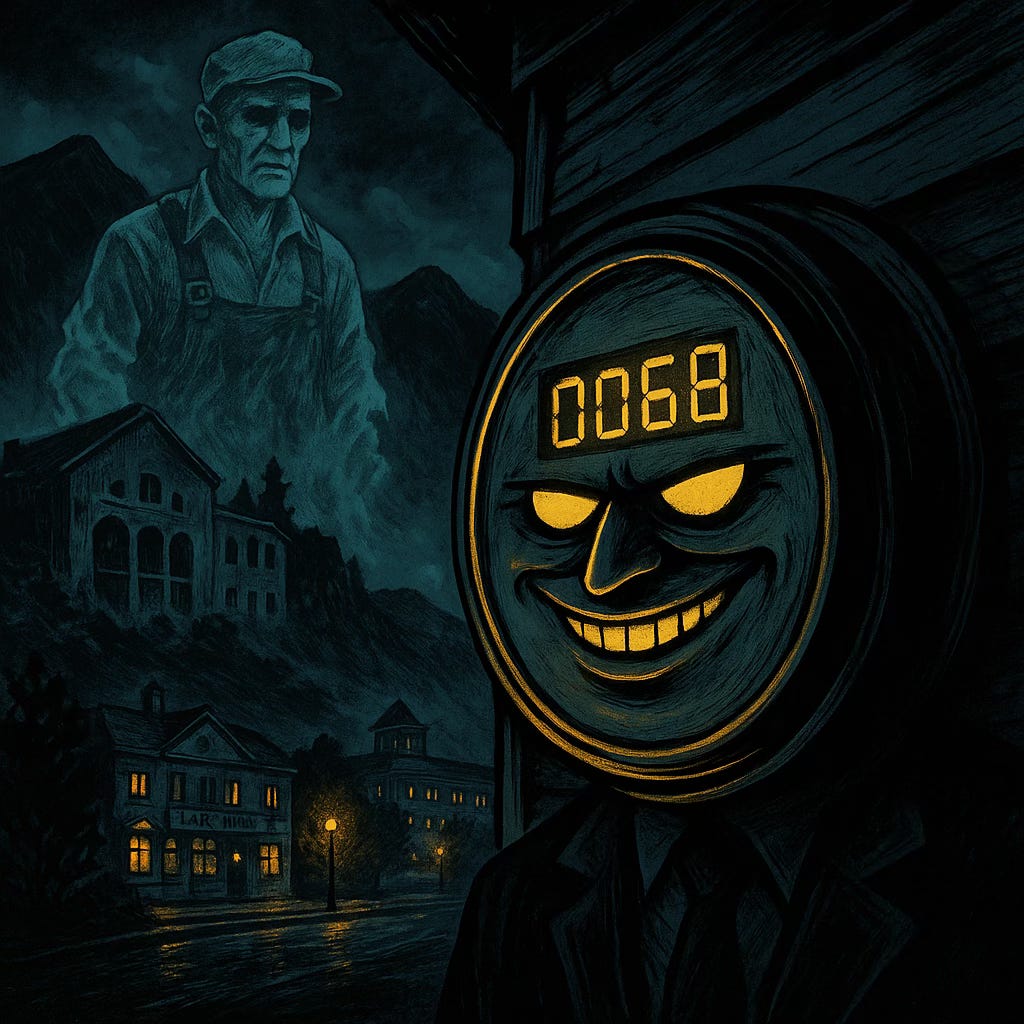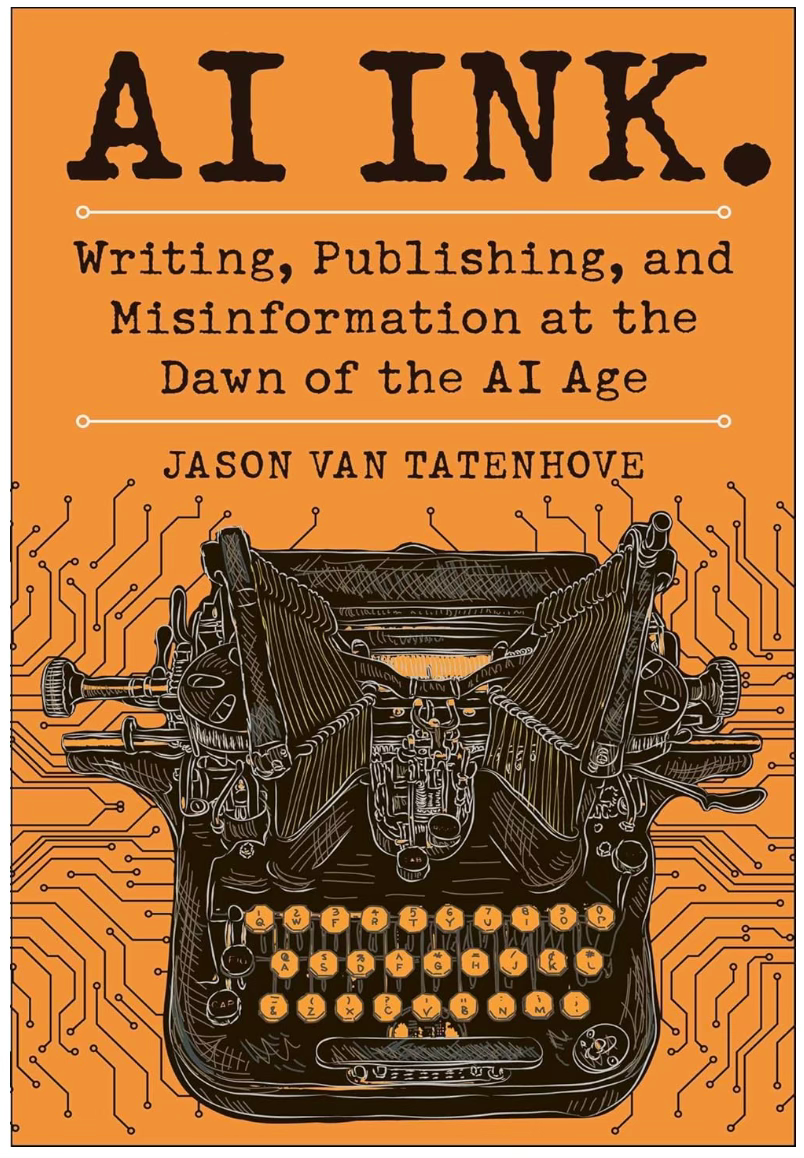THE SMART METER THAT KNEW TOO MUCH
A Gonzo Reflection Into Power, Secrecy, and the Rate Hikes Squeezing a Mountain Town
By Jason Van Tatenhove
I stepped outside this morning for a lungful of cold valley air, letting last week’s flowery love-letter from the town propagandists marinate in my skull.
You know the one — the digital Hallmark card about our “clean energy journey,” written with the same syrupy optimism as a holiday movie but quietly telling us, yet again, that our rates are going up.
And that’s when I saw him.
The smug smart meter.
The one we all have now.
leaning against the siding like a government goon with a digital clipboard.
The little bastard winked.
“Lovely day for rate smoothing, isn’t it?”
THE METER OPENS ITS MOUTH
“Why does my bill keep going up every year,” I asked it,
“while the town quietly transfers Light & Power money into the General Fund? Isn’t innovation supposed to lower rates someday?”
“Reallocation,” it corrected. “We don’t say ‘slush fund.’ Very destabilizing.”
“You’re stealing,” I said.
“Stealing?”
It gasped like I’d insulted its circuitry.
“I simply collect and forward. Whisper-thin increments. A penny here, a dime there. For the good of the community. Your leaders know better than you where your money should go.”
Then it leaned in, display dimming like a conspirator ready to betray the family.
“If you think you’ve got it bad, go talk to the Ghost at the old hydro plant.”
And that is, of course, how I found myself heading toward the museum.
THE GHOST AT THE HYDROPLANT
Inside the Hydroplant Museum, the air smelled like varnish, dust, and stories polished flat enough not to offend tourists.
Then a voice echoed behind me:
“You’re late.”
There he was.
The Ghost of the Hydro Plant.
Oil-stained overalls.
Boots dripping river water that evaporated before it hit the floor.
A face carved by a century of irritation.
“You came for the truth,” he said. “Finally. Nobody else comes here for that anymore.”
I told him about the meter.
He barked a laugh that rattled the pipes.
“Smart meter’s a stooge,” he said.
“Loyal to Town Hall spreadsheets. You think it cares about your bill? It cares about revenue stability.”
He slapped a hand into a turbine casing. It shivered in recognition.
“Back in my day,” he said, “this place actually generated power. F.O. Stanley built it in 1909 to run his hotel — and it ended up powering the whole damn town. Local. Cheap. Honest.”
He sighed.
“It ran until the early 1980s. Then the Lawn Lake Flood tore through here and took out more than machinery. Local control died with it.”
He gestured at the displays.
“They turned the truth into a museum exhibit so they wouldn’t have to deny it.”
Then his form flickered like a dying bulb.
“Go to Town Hall,” he said.
“Ask your questions.
Just don’t expect an answer.”
And then he was gone.
THE BUREAUCRATIC BARNACLE
Town Hall sits on East Elkhorn like a bureaucratic barnacle — unimpressive yet immovable.
I walked up to it, remembering every story this building wishes I’d never written:
The Police Chief's golden parachute scandal
The rotating fire chiefs who fled like smoke
The hospital stonewalling journalists until lawsuits pried records loose
The long, proud tradition of ‘We’ll decide for you’ governance
I reached the doors.
Locked.
Middle of the workday.
Someone inside ducked behind a monitor like I was a wild animal.
I knocked.
Nothing.
This building wasn’t designed for answers.
It was designed for insulation.
THE FIVE LIES
Standing there on Elkhorn, the pattern snapped into focus.
Estes Park survives on five lies.
LIE #1: “Innovation will lower your bill.”
It never has.
Here are the increases heading our way:
2024 → +5%
2026 → +6.3% projected
2027 → +7.5%
2028 → +7.5%
All wrapped in cheerful prose about “the journey.”
LIE #2: “Your utility money stays in your utility.”
Except when it doesn’t.
The 2016 Comprehensive Annual Financial Report shows $736,059 moved from Light & Power into governmental activities.
Not rumor.
Not speculation.
Documented.
“Reallocation,” they call it.
LIE #3: “We’re all in this together.”
Sure.
If “together” means:
Administrators make six figures
whileWorkers choose between rent, groceries, and heat.
Residents pay the highest per-kilowatt-hour rates because we’re the easiest group to squeeze.
LIE #4: “You have a voice.”
Except:
No vote on the PRPA contract to 2075
No vote on rate hikes
No vote on utility transfers
No vote on major capital blunders
No vote on the financial decisions shaping our lives
Estes Park has perfected government without participation.
LIE #5: “Transparency is a core value.”
Transparency only applies when nothing important is being asked.
Journalists have had to sue — multiple times — for public records.
Emails.
Lawyers.
Polite refusals.
Silence.
This is the real language of Town Hall.
THE DARK HOUSE
By the time I got home, the valley had settled into that deep alpine indigo.
I stared at the meter.
Then went in and turned off every light in my home.
The meter sputtered outside.
“Citizen, this behavior is not conducive to revenue stability!”
“Good,” I yelled through the back window.
In the dark, lit only by my laptop, I finally admitted what we all know:
People here feel powerless because the system was designed to keep them powerless.
So I did the only thing left that still feels honest.
I started writing a fiction about a town where:
Leaders tell the truth
Utilities are transparent
Unused funds return to the people
Referendums exist
Accountability is real
Journalism holds power to account, but not when the historical town paper of record has been drained of all it’s lifeblood.
public servants remember the “public” part
A town Estes Park has never quite been —
but could be.
THE RECKONING
Here’s what Town Hall can’t seem to see:
If the cost of living keeps rising,
and wages stay poverty-low,
and workers keep getting pushed out —
There will be no one left to run this town.
No teachers.
No nurses.
No cooks, baristas, or servers.
No firefighters.
No EMTs.
No child-care workers.
No cops who can afford to live here.
No hospital techs.
No maintenance crews.
A town without workers is not a town.
It’s a hollow tourist diorama.
Tourists don’t check themselves in.
Elk don’t stock grocery shelves.
And “clean energy journeys” don’t make coffee.
THE HISTORY THAT MAKES IT WORSE
Estes Park has always been a tourist town.
And where there is tourist money, there is tourist politics — the polite, quiet kind that lives beneath the brochures.
There have always been two Estes Parks:
The myth sold to visitors
The reality carried by workers
And the gap between them grows wider every year.
This valley doesn’t run on luxury cabins.
It runs on people.
And we’re losing them.
THE LAST WORD
Campaign promises won’t fix this.
Slogans won’t fix this.
PRPA won’t fix this.
Elections will.
Accountability will.
Electing locals that are actually for the people will. Not those that sing a catchy little song during the campaign, then forget the promises they made…
If the people running this town can’t see that affordability is survival, then they shouldn’t be running it.
So yes — organize.
Elect better.
Hold the rest accountable.
And vote the useless ones the fuck out.
Next election.
Every election.
Until this town belongs to the people who actually live here again.
Estes Park is worth fighting for.
Not the brochure.
Not the PR fantasy.
The real one.
Built on workers.
Built on locals.
Built on us.
The ghost at the hydro plant was right:
Power used to belong to the people here.
Maybe it’s time it did again.
~JVT
PS: Watch later this week for a new video podcast episode!
Now available in Hardcover and Kindle editions. Audible coming soon!



